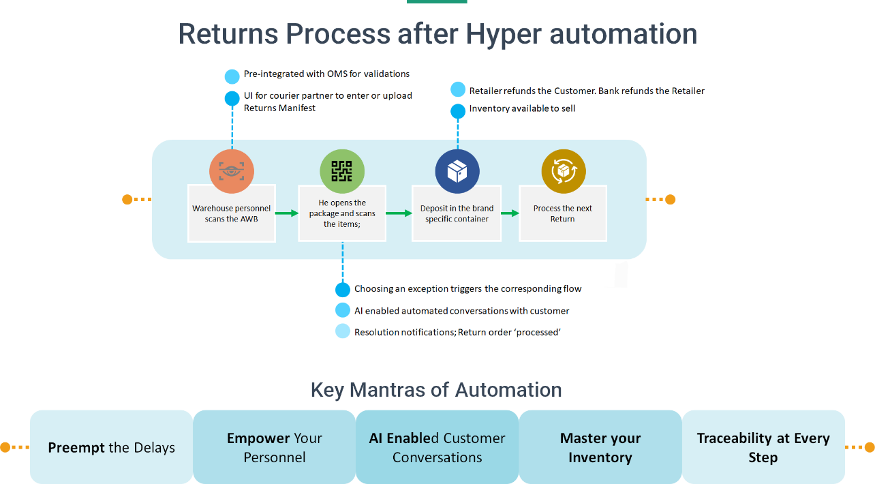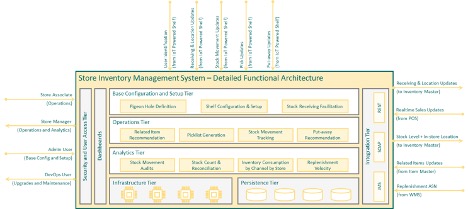
Think Tank
The Missing Cog in Turning Retail Stores Into Micro-Fulfillment Centers
Omnichannel retail today is as much a myth as it is a reality.
It’s a myth because of rapidly developing trends in retailing, both technological and behavioral. As disruptive technologies emerge — mobile, the internet of things, the cloud, robotics process automation — changing customer behavior is confronting retailers with the ultimate challenge: how to provide a seamless omnichannel “brand experience.”
Retailers need to ensure a consistent experience across channels, increased efficiency at the warehouse and on-time delivery, including the ability of customers to buy online and pick up in store (BOPIS).
It has never been more important for retailers to know the precise amount and location of their inventory. Lack of such knowledge leads to both overstocks and stockouts. One survey found that $1.1 trillion is lost in revenue from those two errors. Up to 42% of customers encountering a stockout will go to another store to shop. Lack of inventory visibility leads to an incorrect understanding of store capacity, mismanaged backroom space, and faulty ordering and replenishment. To make matters worse, retailers are shifting inventories from warehouses to stores, placing even more importance on accurate inventory levels.
The ability to optimize and digitally manage racks is the missing cog that will turn stores into fulfillment centers, making best use of store capacity at a minimal cost. Key to that goal is adoption of a store inventory management system (SIMS).
The current state of inventory management in stores suffers from the following shortcomings:
- Racks and storage areas are managed manually, and putaway of items happens sequentially, through dependence on archaic processes.
- Backs of the shelves are unattended, increasing the shelf life of those items.
- Manual processes cause space leakages.
- When customers demand alternative items, there is limited knowledge of where those items are.
- There’s no tracking of inventory movement, from receipt to the point where inventory is sold.
- Manual picking increases the time that customers must wait for the store associate to come back with alternatives.
- Large areas of the shelves (especially the back areas) are unused because it takes extra effort to reach them.
Figure 1 illustrates these shortcomings.

Figure 1: Shortcomings of Current Ways of Managing the Store Backroom
SIMS meets those shortcomings head-on, turning them into opportunities for retailers to manage stores more effectively. It generates a digital definition of storage areas, identifies all personnel, recognizes relevant activities, identifies items through barcode, records the activity against the items, closes the record when the items are sold, and reopens the record if they’re returned. Figure 2 provides a clear illustration of the process.

Figure 2: Merits of Enabling Backroom Storages Spaces using SIMS
Advantages of equipping retail stores with SIMS include:
- A completely automated way of identifying a pigeonhole to put away any item in the backroom. This allows the associate to simply generate a putaway list at the end of the day, and insert each item into the prescribed pigeonhole.
- Every inch of every shelf is defined in the system as a part of the initial setup, significantly increasing the capacity of the store backroom at no extra cost.
- Space leakages between items do not occur, due to the digital definition of the shelves in SIMS, and the dimensions of items.
- When customers demand alternative items, a quick lookup identifies all related and complementary styles.
- Every time an item is picked or put away, an audit trail is created, tracking the entire process from receipt to sale.
- The time required to attend to customer requests is significantly reduced, due to systematic identification of pigeonholes where those items are in the backroom.
- The identity of the associate picking or putting away items is recorded for greater visibility.
Application Architecture of SIMS
SIMS enables functionality at a high level (Figure 3), and provides a snapshot of the detailed level application architecture (Figure 4). Modules include:
The base configuration and setup tier handles the initial one-time setup of the shelves and pigeonholes according to length, width and height. Edits to these definitions are also allowed in the lifecycle of a SIMS-enabled store.
In order to bifurcate fortnightly, monthly or weekly replenishments from daily picking and putaway, this module also handles the receiving process, by generating the list of pigeonholes for the receiving process. This is accomplished automatically through integration with the warehouse management system (WMS), which allows SIMS to prepare the putaway list well in advance of the truck arriving at the store.

Figure 3: High-Level Enterprise Application Architecture of SIMS
The operations tier facilitates the day-to-day operations of the store associate by helping with picklist generation, related item recommendations, stock movement tracking and putaway recommendations.
This module is integrated with the IoT-enabled shelves, allowing for the receipt of real-time updates during store hours, with store associates serving both walk-in and BOPIS customers.
It tracks the identity of associates, inventory movement, items picked for each recommendation as well as all violations, including items not stored in the recommended location, or ignored for a recommendation. These insights can be intuitively used by the store manager to calibrate the performance of store associates.
The analytics tier provides insights and operational intelligence that can be used by the central inventory repository, store associates and store managers alike. The insights can also help top management gain deeper insight into store operations.
Stock-movement audits provide traceability of each item, including location and eventual state – sold, missing or picked by a particular associate.
SIMS enables the entire stock-counting process with the press of a button. Periodic stock count updates can be sent to the central repository for reconciliation, resulting in increased accuracy of the overall inventory picture. In addition, SIMS always knows the split of demand by channel, and replenishment velocity can be determined at an item level. Movement of an item within the store provides merchandisers with a view of the popularity of the item before it was sold. These parameters help them to fine-tune their merchandising strategy and procurement cycles.
The infrastructure tier details the hardware needed by SIMS to function at average and peak levels of store traffic.
The persistence tier defines a secondary storage mechanism.
The security and user access tier provides an authenticated and authorized mechanism for parties to access SIMS according to their various roles. SIMS can integrate with any data warehouse, and give top management a view of daily operations of a single store, group of stores or the entire network.
Configurable dashboards allow each role to carry their daily operations seamlessly.
The integration tier aids in communication with all peripheral applications via various integration mechanisms.

Figure 4: Detailed Enterprise Application Architecture of SIMS and the Integration Touchpoints
The Measurable Merits
The potential impact of SIMS on omnichannel retailing is huge. Benefits include:
- It reduces turnaround time for an associate to attend to the customer by 50%, from the current average of five minutes to about 2.5 minutes. A customer will leave the store if it takes more than three minutes for the associate to get back with alternative options.
- It increases traceability and reduces theft, which surged to $62 billion in 2019.
- It increases accuracy, thereby preventing overstock and stockouts. BOPIS can be routed to a store that has the item in stock.
- It increases storage capacity by 30%, allowing the retailer to better serve online and offline orders. There is a direct correlation between proper management of storage space and profit margins.
- It ensures that an item is available and in the right location for picking.
SIMS can serve as an integral cog in omnichannel retailing, and contribute to a seamless customer experience.
Guruprasad Nagaraja is enterprise architect for retail and supply chain with Tietoevry.






